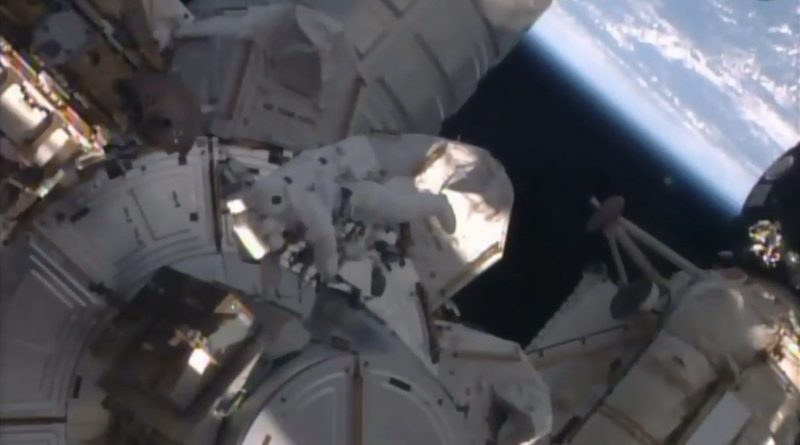Stuck ISS Robotic Transporter freed up by Spacewalking Duo
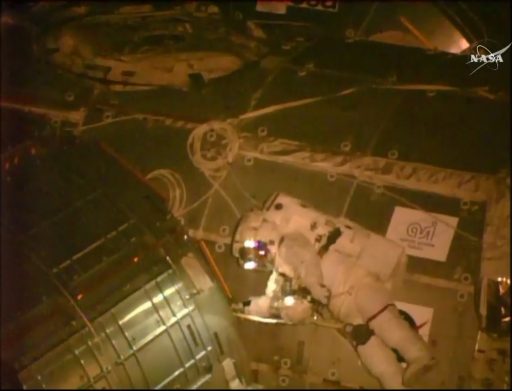
Two Space Station Crew Members ventured outside the hatches of the International Space Station on Monday in an EVA organized on very short notice to recover from an undesired situation involving the Station’s Mobile Transporter that had gotten stuck in between work sites on the central truss of ISS.
Scott Kelly and Tim Kopra, both EVA veterans, were successful in releasing brakes on an equipment cart attached to the Mobile Transporter thus allowing robotics controllers to command the transporter to move to a safe work site. Given the quick resolution of the MT issue, Kelly and Kopra were able to handle a pair of get ahead tasks before returning to the airlock after a successful excursion lasting three hours and 16 minutes.
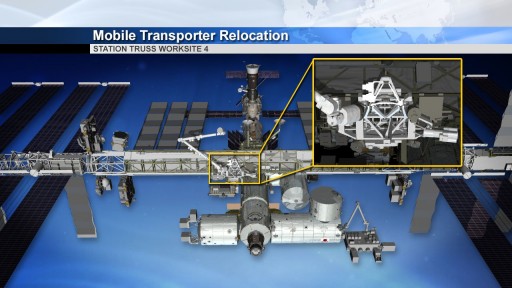
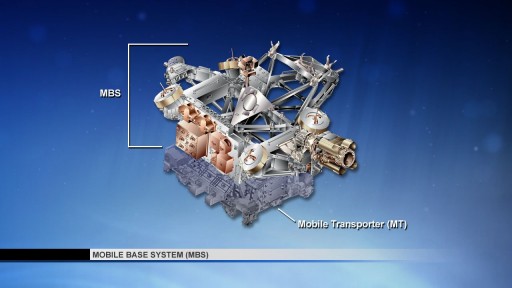
The need for an unscheduled spacewalk arose last Wednesday when the Mobile Transporter departed Work Site 4, en-route to Work Site 2 for upcoming operations. Just moments after leaving the work site, the Mobile Transporter’s Motor Controllers were showing fault messages. Repeated attempts in different drive modes did not resolve the situation and the MT had to be considered stuck for good – just ten centimeters from Work Site 4 where it can be locked down and connected to power and data systems.
The urgency in the situation was caused by the inbound Progress MS spacecraft, launching successfully atop a Soyuz 2-1A rocket on Monday, just four hours before the crew began their EVA. Progress is aiming for an automated docking to the Pirs Module on Wednesday for the delivery of over 2,300 Kilograms of cargo. The concern associated with the arrival of the Progress was that the Mobile Transporter could shift either during attitude maneuvers conducted by the Space Station or when Progress makes contact with its docking port.
Mission Controllers and engineers worked tirelessly starting on Thursday to put procedures together covering all eventualities from the best case scenario of just having the crew release brake handles to more complex scenarios like decoupling the carts from the Mobile Transporter. In orbit, the crew was busy on Saturday and Sunday to prepare the suits and tools for the spacewalk originating from the Quest airlock on the U.S. Segment.
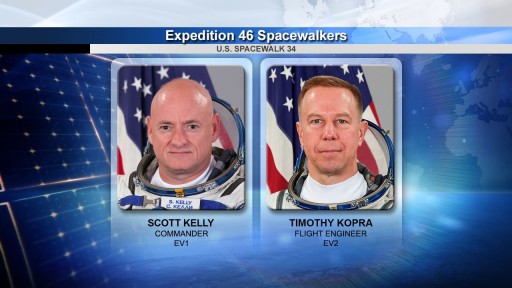
Chosen for the job on short notice were Scott Kelly, on his 270th day in orbit, and Tim Kopra on his 6th Flight Day after having just headed into orbit aboard Soyuz TMA-19M last week. Both are spacewalk veterans – Kelly performed a pair of EVAs in October and November with Kjell Lindgren for a total of 15 hours while Tim Kopra can look back at one prior EVA conducted in 2009 for five and a half hours.
Getting up very early on Monday, the crew members headed into EVA preparations assisted by Tim Peake and Sergei Volkov. Initially, the crew started with a one-hour pre-breathe of pure Oxygen using masks before heading into the airlock and reducing its pressure to facilitate their ingress into the suits that was followed by communication, telemetry and biomed data checks with Mission Control. When both were inside their suits, the crew started the 100-minute pre-breath that included light exercise to remove nitrogen from their blood in order to avoid decompression sickness during the EVA.
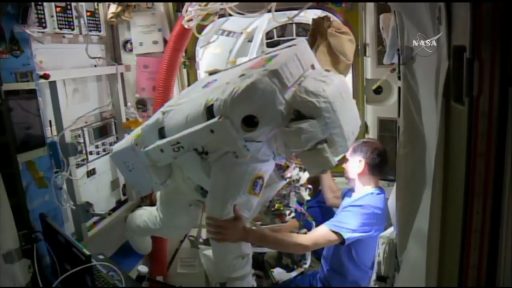
Working through their timeline efficiently, Tim Peake and Sergei Volkov attached the SAFER jetpacks to the Extravehicular Mobility Units before moving the crew members into the crew lock portion of Quest. After the closure of the internal hatch of Quest, the airlock was depressurized and the external hatch of Quest was opened by Scott Kelly, serving as EV-1. The EVA officially commended at 12:45 UTC when the spacewalkers switched their suits to battery power.
Scott Kelly was first to climb out of the airlock, setting up tethers before giving Tim Kopra a GO to return to the outside after over six years since his first EVA. When both were outside, they went through the prescribed checks of their suits before receiving a GO from Mission Control to depart the airlock and make their way to the S0 truss segment where the Mobile Transporter got stuck.
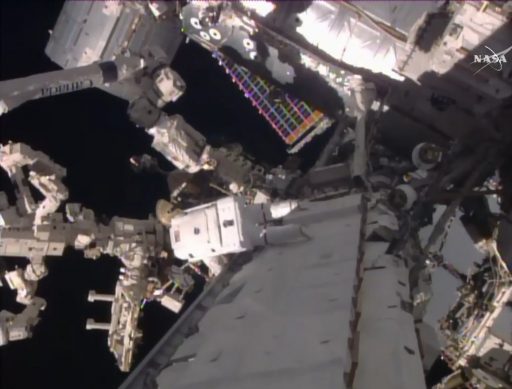
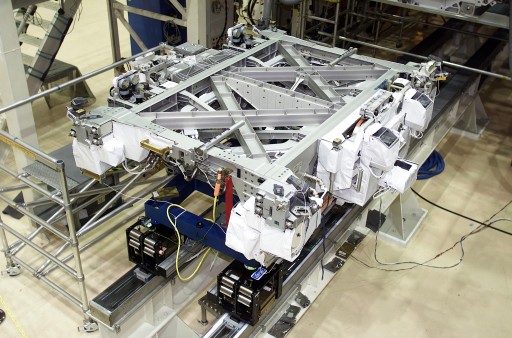
The Mobile Transporter was delivered to ISS along with the S0 truss on Space Shuttle Mission STS-110 in the spring of 2002. It rides on rails and is capable of moving 108 meters along the Space Station’s Truss. Installed atop the MT is the Mobile Base System MBS which provides Power & Data Grapple Fixtures (PDGF) for the robotic arm so that it can be moved to any position along the long truss segment when riding the transporter.
Reaching a top speed of 1.5 meters per minute, the Mobile Transporter can transition between ten work sites along the truss where it can be secured and locked down to provide a stable platform for robotic motion and spacewalk operations. The MBS is 5.7 by 4.5 by 2.9 meters in size with a total mass of 1,450 Kilograms without any external equipment using a structure made of aluminum and titanium for extra strength.
Scott Kelly arrived at the CETA (crew equipment and translation aid) cart on the starboard side of the Mobile Transporter while Tim Kopra translated to the port CETA Cart. When needed, the carts can be detached from the Mobile Transporter and moved by spacewalkers to handle larger equipment. When not in use, the carts are attached to the Mobile Transporter and ride along with it. Each CETA cart, using an aluminum structural frame, measures 2.5 by 2.35 by 0.89 meters in size with a total mass of 283 Kilograms.
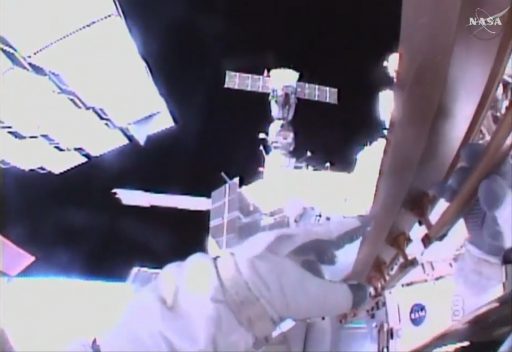
Mission Control had suspected that one of the brake handles on the starboard CETA cart had gotten engaged inadvertently during U.S. EVA-33 in November when the brake handles were tied down by Scott Kelly. There are four brake handles on each CETA cart – two Parking Brake Handles on the port and starboard side of the cart, and two Dynamic Brake Handles, also on either side of the cart.
Scott Kelly got in position at the CETA cart and attempted to wiggle it in the aft-forward direction, reporting that the cart was rock solid. He then actuated the brake handles to release the brakes which appeared to do the trick as the Cart was now free to move alongside the Mobile Transporter again. As a precautionary measure, Tim Kopra did the same on the port cart, releasing its brake handles, though it had been confirmed that the culprit was the starboard cart as had been expected.
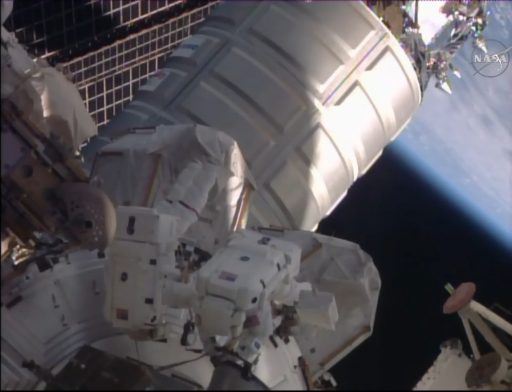
With the CETA Carts again free to move, the crew members retreated from the Mobile Transporter and Robotics Controllers at Mission Control prepared the command sequence to move the MT back to Work Site 4. Both crew members reported the MT was in motion at 13:19 UTC and it quickly reached Work Site 4 where magnetic indicators signaled to the MT that it was centered in position to be latched down. New commands were sent up to instruct the MT to get latched down at WS 4. Good latching was confirmed at 13:31 UTC and work got underway to connect the MT to the electrical system of the Work Site, a process that took several minutes and placed the MT back into its fully secure configuration with power being provided to the robotics system via the primary power link, no longer requiring the contingency power transfer system.
With the CETA Cart brakes disengaged and the handles in a good tie-down configuration, the Mobile Transporter should not run into this problem again anytime soon. The MT will likely attempt the trip to Work Site 2 towards the end of December after the Progress arrives at ISS to ensure it is fully functional and ready for continued operations.
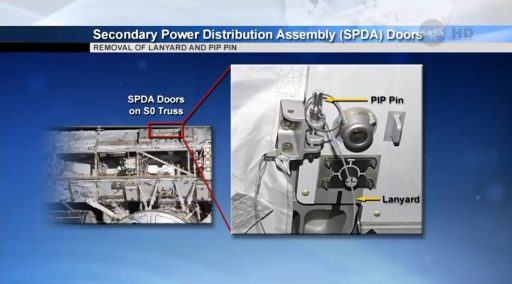
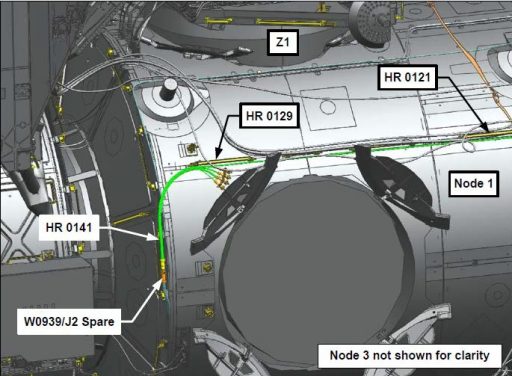
Having completed the MT task in just a little over half an hour, the crew got started with a pair of get ahead tasks. The first was completed by Tim Kopra while still at the S0 work site, opening of a Secondary Power Distribution Assembly Door to enable the Dextre Robot to access modular components of the Electrical Power System such as switches and circuit breakers for robotic maintenance operations as have been performed in the past.
The second get ahead task was the routing of cables – two activities left from previous spacewalks. Tim Kopra retrieved the yellow W5946 Ethernet Cable that had been stowed in the gap between Node 1 and Node 3 by Luca Parmitano in his infamous 2013 spacewalk during which he battled with a significant water intrusion into his helmet leading to an early termination of the spacewalk.
Kopra picked up the cable and went through the tedious process of routing it across Node 1 and Pressurized Mating Adapter 1 to a stowage location near the Zarya module. On a future Russian spacewalk, this cable will be picked up and positioned for the arrival of the Multipurpose Laboratory Module ‘Nauka’ that is currently looking at a launch date in 2017 after several years of delays.
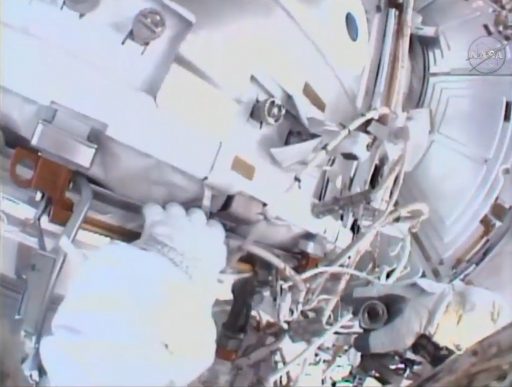
For Scott Kelly, the task was to finish routing a pair of cables that were part of the EVA-32 plan for him and Kjell Lindgren. He picked up the coiled W2289 power cable at the U.S. Lab that was routed halfway in the October EVA but needed to be taken forward across the lab and to a location close to the Zenith Common Berthing Mechanism on Node 2 where Pressurized Mating Adapter 3 will be relocated next year ahead of the installation of International Docking Adapter 3 to establish the docking ports for SpaceX and Boeing’s Commercial Crew Vehicles. Next, Kelly routed a yellow power cable from the Node 2 location aft across the lab and to Node 1 where he plugged it into an external patch panel (J603).
Tim Kopra finished his cable routing task with time to spare so he was sent up to the Z1 truss to a tool box where he retrieved a pair of EVA tools that he then stowed in the airlock. Making his way over to the Destiny Lab, Kopra picked up an empty equipment bag that was used to bring cables to their installation location. He then headed back to the airlock, conducted a tool inventory and got a few precious minutes to marvel at the Earth below as Scott Kelly still had his hands full tying down the yellow power cable at the Node 2 module.
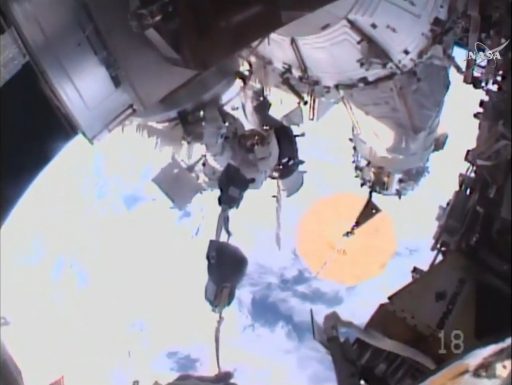
Calling it a day, both spacewalkers ingressed the airlock, this time Kopra led the way, and both connected their suits to ISS power and cooling systems before closing the external hatch of the Quest airlock. The conclusion of Monday’s EVA was marked at 16:01 UTC when the repressurization of the airlock commenced, bringing EVA-34 to a total duration of three hours and 16 minutes.
Accomplishing all their tasks, the spacewalkers can add to their existing EVA records. With two previous EVAs conducted as part of his one-year mission, Scott Kelly can now look back at 18 hours and 20 minutes spent outside the Space Station. Tim Kopra, conducting his second career EVA, now has 8 hours and 48 minutes of EVA time under his belt. For the Space Station, EVA-34 was the 191st spacewalk in support of ISS Assembly and Maintenance for a total of 1,195 hours.
The next spacewalk is currently targeting the mid-January time frame for the replacement of the Sequential Shunt Unit out on the Station’s truss segment that failed back in November and knocked one of the Station’s eight power channels off-line. The spare SSU is currently planned to undergo in orbit testing beginning on Tuesday to ensure the replacement is functional ahead of its installation. The January spacewalk will be conducted by Tim Kopra taking the role of lead spacewalker and European Astronaut Tim Peake conducting his first EVA.
A Russian spacewalk performed by Sergei Volkov and Yuri Malenchenko is currently scheduled for February.

